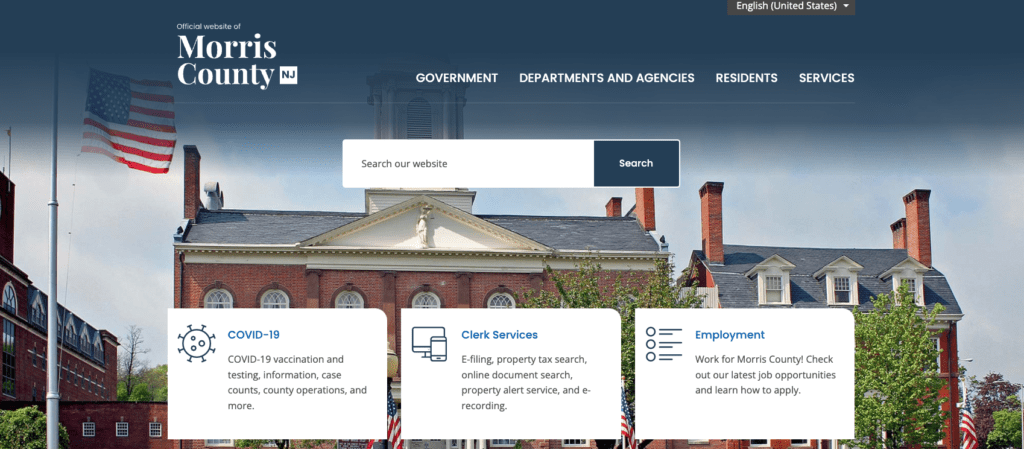We recently caught up with Jamie Klenetsky Fay, Digital Media Manager for Morris County, NJ to get an update on what her agency has been working on since the last time we spoke.
In this article, you can listen to her interview in the audio clip or read the transcription.
Karl: Welcome everyone! Today we are catching up with someone we spoke to what feels like years ago, before the pandemic started. It’s actually only been about two years since we last caught up, but in pandemic time, it’s been a lifetime at this point.
When last we spoke, we were discussing best practices for web design in local government and you mentioned there was a new website being launched for Morris County. At the time it was very hush, hush, secret, secret. But now we’re here and the cat’s out of the bag, so you can talk a lot about it. And so that’s what we’re going to do. Jamie, thanks for joining me. It’s good to see you again.
Jamie: Thanks for having me!
Karl: For those who don’t know, could you give us just a quick introduction on who you are and what you’re doing?
Jamie: Sure – I’m Jamie Klenetsky Fay and I’m the Digital Media Manager for Morris County in New Jersey. We’re a suburban county outside of New York City with approximately half a million people living here.
My role is such that if there’s some technological thing that touches the public in some way, I’m probably involved. That means I’ve done everything from web design and development to social media management, to even video production. A lot of what I do is manage our online services through GovOS Studio.
Karl: So when we talked last, the website project was in progress, but it wasn’t at a point where you were ready to share yet. When did the site officially go live? And can you give us just a quick overview on what changed with the site?
Jamie: The project was a very comprehensive website update that launched March of 2021. The reason this was such a huge project was due to massive siloing over the years. The county’s website was actually comprised of 16 websites for various departments and divisions. We knew that was a terrible idea and very hard for the public to navigate through. So, the project was really a giant information architecture puzzle—putting everything together and making one website out of all these websites.
It was an interesting time, and it was a little stressful to do during a pandemic working remotely for the first time.
Karl: How did you take inventory of these 16 sites that were “Frankensteined” together and how did you come out with a streamlined website for the county?
Jamie: It was a long process. Fortunately, the actual content audit didn’t need to be edited too much. We use a tool called SiteImprove, which, among other things that it does, has an inventory feature, where if you have a website that’s being fed through the tool, it will gather all the URLs on that site for you, and that was very convenient.
So the pages were easy enough. Knowing what was on each page and whether it needed to come through to the new site was a little harder. I went out and found someone who would work with us as a partner and really focus on the user experience and information architecture, and that person actually hired a third party to help because there was so much content. It was wild.
Then working with each of these divisions and departments to literally write out on a spreadsheet, “Do we need to keep this content? Do we need to revise this content?” and going through each page one at a time, it was a journey. It was a lot.

Karl: Can you talk a little bit about how you used the GovOS Studio platform—which helps you digitize forms and workflows and processes—in the site redesign and relaunch?
Jamie: Oh, so helpful. When you’re redoing a website you realize, “Wait a minute, we have all these PDF forms and these are terrible. We need to do something with them!”
However, when we started with GovOS (previously SeamlessDocs), which was before we did the website, I talked to my now retired editor who was my previous manager, and I said, “Okay, we need online digital services, and we need a new website. We need both things, but if we’re going to push for something, what should we push for?” And he made the executive decision to digitize forms first.
So, while we had this extremely antiquated, scattered website network, I spent a year or so working with all these agencies and getting their forms online. As a result of that, we just didn’t need to focus on forms when we were redoing the website. Anyone who came into the fold during the redesign process would learn about Studio and what it could do for us. There were certain services that we converted to forms that we didn’t previously offer. It was an enormous help!
It also meant that we didn’t need to find another new vendor while redoing our website. It was all kind of taken care of and honestly having those digital services in place during COVID, even before we redid the site, was huge. We were just ready, you know?
Karl: I can totally relate to that. We talked to our partners at Fort Lee, NJ when the pandemic started and the mandates from the state in terms of keeping employees safe — they seemed to be coming so quickly, with serious fines for lack of compliance. I’m sure having your forms in place at a time where everything was in flux was helpful too.
Jamie: Honestly, thinking about it now, if we didn’t have a digital services platform in place already, I don’t know how we could have done the website redesign. I don’t even know how it would have been possible because there were so many moving parts as part of that. But having forms online became so critical during COVID, especially when we all started working remotely, I don’t know how it would have been possible if we didn’t have that already.
Karl: Well, I’m glad we were able to help. Talk to me about some of the best practices you incorporated into the website. Are there maybe one or two things you wanted to call out that you felt were a real improvement from how you were doing things before?
Jamie: Absolutely. One is the use of plain language, wherever you can. It’s a big issue on government websites. We tend to speak in government speech—often in postgraduate reading levels—and there are algorithms we use to analyze our website copy and determine what level we’re writing at.
We used HemingwayApp.com to analyze our text. Another great resource for this is a website developed and maintained by the federal government called PlainLanguage.gov that details best practices that governments should follow when communicating with citizens. The “Before and After” section on this site is helpful. Some examples are real, and some are fake, but it’s very interesting to see how common, everyday copy can be reworded.
Because to be widely accessible, text and copy should be a grade-school level, and when it’s not it’s a huge disservice to your citizens who might not have that education level. Also, most people reading your site are probably busy, and they might be just scanning the text instead of really reading and processing it. Or maybe English is their second language, and they rely on a translation tool to help them interpret what’s on the screen.
So, wherever we could, I worked with those folks to simplify their message, especially on their service pages, and I think others should focus on that, too. If you don’t have the time or funding to do an entire redesign of your site, just updating the copy can make a real difference. Because at the end of the day, it’s really all about content and structure. People don’t need a shiny new layout to be able to get things done. They need to find what they’re looking for and understand what they’re reading when they get there.
Karl: Was there another best practice you wanted to mention?
Jamie: Sure—one other goal was to surface our services, to break them out of divisional silos that people shouldn’t need to understand. For example, is it “trash” pickup, “garbage” pickup or “rubbish” pickup? People shouldn’t have to know which word it is, they should be able to find it no matter what they search for.
On our website, we broke it out so that there’s only four top-level nav items, and one of them is services and you can just go find your service and you don’t need to know who’s running the service. Of course, on every service page we still list all of our departments along with contact information, but this just makes the site easier for people to find what they need.
And, if you think about it, not everyone is Googling to get to your site. Most people still come through the homepage, at least in our case, and if someone comes to our site because they need to apply for cash assistance, they shouldn’t have to hunt through our website to find contact information about that. It should just be there. So that was a huge focus for us.
Karl: What comes next for the county in terms of digital transformation?
Jamie: After we launched the main county site, we launched some “companion” sites, or sub-sites, whatever you want to call them. They were like micro-sites for agencies that really did need a standalone web presence, which was our county clerk and our library. Those projects were going on and they just finished, which is exciting.
I think we’re going to focus on more content development for next year. I would love to dive into some of our services areas of the site that I wasn’t able to touch that I had to kind of bring over as it was at the time. I also want to get us up and running with online payments, which we’re starting to implement for a few services.
Karl: What would you like to sign off with, for anybody who’s watching?
Jamie: I think any change you make can help—you don’t need to do it perfectly. There’s no way to do this perfectly! But if you can take a page and simplify it, if you can bring a service to the top and you could advertise it on your Facebook page—anything you do is going to make it easier for people. If you think about it like that, it makes the job easier, and I think it is a lot more rewarding, too.









